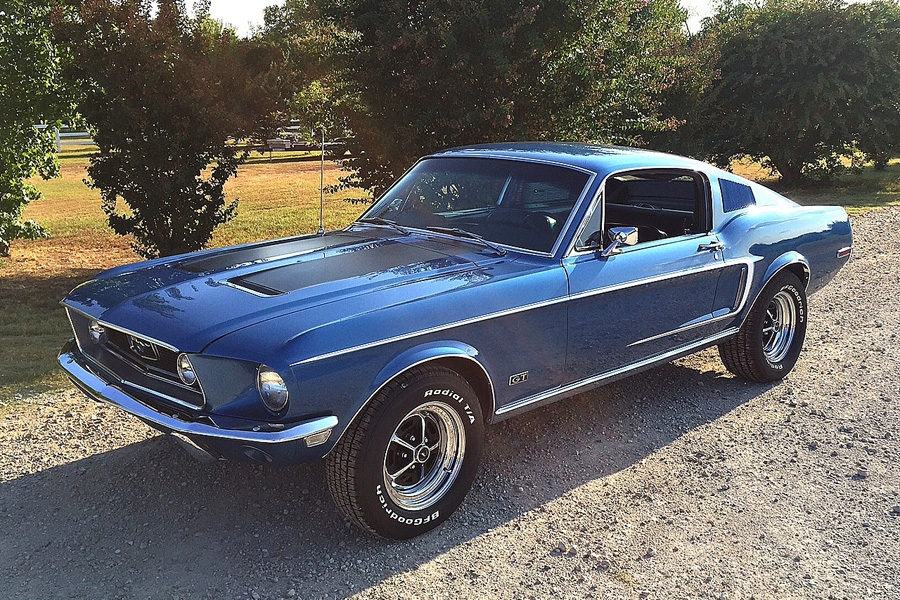SCM Analysis
Detailing
| Vehicle: | 1968 Ford Mustang GT 390 S-Code fastback |
| Years Produced: | 1967–69 |
| Number Produced: | 18,838 (1968 Mustang GTs) |
| Original List Price: | $3,500 |
| SCM Valuation: | $28,800–$34,800 |
| Tune Up Cost: | $300 |
| Distributor Caps: | $11 |
| Chassis Number Location: | Passenger’s side dashboard (1968 only) |
| Engine Number Location: | Back of engine block, right-hand side above starter |
| Club Info: | Mustang Club of America |
| Website: | www.mustang.org |
| Alternatives: | 1970–71 Dodge Challenger, 1967–69 Chevrolet Camaro, 1968–70 AMC AMX |
| Investment Grade: | C |
This car, Lot 468, sold for $56,100, including buyer’s premium, at Barrett-Jackson’s Las Vegas sale on September 24–26, 2015.
The first-generation Ford Mustang is a gold-standard collectible. Even though the Mustang was never particularly rare and a whole lot of them survived middle age, it has become one of the cornerstones of American car collecting.
Last year, as part of the 50th anniversary celebration of the Mustang, Lee Iacocca was quoted as saying, “I had a vision of an American-made four-seat sporty car. We had no data, but I felt there was a market to be driven by baby boomers.” Iacocca was right — the boomers embraced the Mustang, and Ford dealers sold 22,000 of the new pony cars on the first day of sales.
But the project wasn’t done yet. Iacocca called Carroll Shelby and asked him to make the new car perform. Shelby recalled it like this: “In 1964, Lee Iacocca said, ‘I want you to make a sports car out of the Mustang.’” Shelby tried to beg off, famously calling the new Mustang a “secretary’s car” and a “mule.” But Iacocca insisted, and put the weight of Ford Motor Company on Shelby’s arm. The rest, as they say, is history. Not even two years later, Shelby was bragging about “blowing off a Porsche with a $3,900 donkey.”
A potent package
By 1968, the Mustang had seven listed performance levels, ranging from the 200-ci Thriftpower 6-cylinder at 120 horsepower up to the 427-ci V8 at 390 horsepower, which was listed as an option but is rumored to have never been produced.
Near the top of the list was the 390-ci S-code package, rated by Ford at 325 (some models at 335) horsepower and 427 pound-feet of torque. When mated with the 4-speed manual transmission, this was a potent pony car. The S-code engine added $263 to the 1968 Mustang fastback base price of $2,689, and the 4-speed transmission cost another $233. Buyers also ended up paying about $300 more for required options like power brakes, power steering and the GT equipment group.
But what you got for your money was an amazing car. Weighing in at about 2,800 pounds fully dressed, you got a quarter-mile time in the 13-second range at 105 mph right off the showroom floor. The 1968 Mustang GT 390 fastback was the basis for the legendary “Bullitt” car driven by Steve McQueen. When it comes to street cred, you can’t do much better than that.
Unicorn or workhorse?
That brings us to this particular 1968 Mustang, and it’s an impressive car. The listing states that the car underwent a complete restoration with attention to details like the underbody oxide coating and correct C-stripe sweeping back along the belt line from the headlight and down around the side cove. Acapulco Blue is an attractive color, and plenty of care was taken to put the interior back to dealer showroom condition.
This car was sold at Barrett-Jackson’s Las Vegas Auction for $56,100, including the 10% buyer’s premium, which means the winning bid was $51,000. That’s above our current rating for a good #2 car at $28,800 to $34,800, but this car was nicer than your average good #2. The price paid was in line with what we’ve seen for similar examples in this condition, so it’s fair to say that both the buyer and seller got a fair deal here.
But, depending on your point of view, a few of the restoration decisions on this car might be troubling. The seller updated the original power steering with a modern variable assist electric unit with a cockpit-mounted controller, and modified the engine with an aftermarket cam, intake, heads, headers and exhaust. That probably boosted the engine power a bit, and the power steering will be very nice, but did the car really need it?
If you want to buy a Mustang for track use, you’d be better off buying something roughly 10 years old for about 20% of the purchase price of this collectible. It’s safe to say no one’s going to be flogging this vintage GT on a racetrack anytime soon. Further, will anyone notice a few extra horsepower out on the street? If you wanted to make a driver Mustang, why spend the money on a real original S-code?
Rare, and will be original
According to the seller, just 65 Mustangs were made in this exact specification. As Mustangs go, that’s a pretty rare combination. In the collectible world, I have to believe that this car would be just as valuable — if not more valuable — with everything restored as the factory made it. The good news is that nothing was done here that can’t be easily undone, and my bet is that within 10 years, this car will be back to its stock configuration. As time goes by, this car’s originality will be too valuable to do otherwise.
(Introductory description courtesy of Barrett-Jackson.
